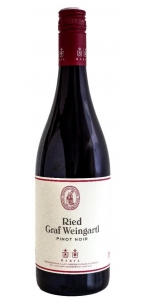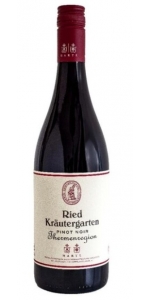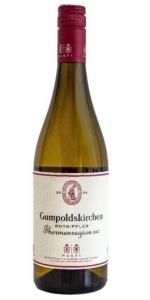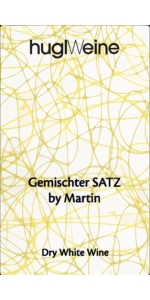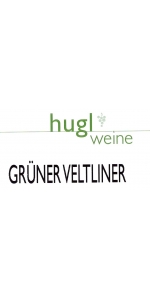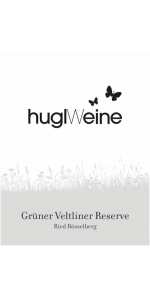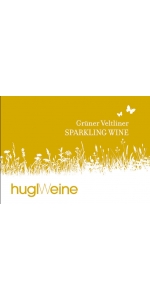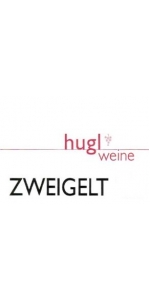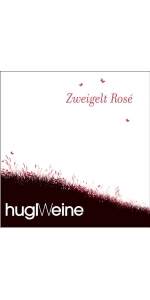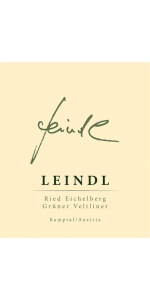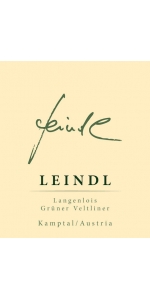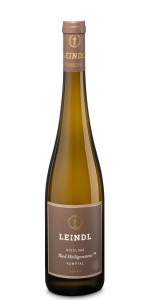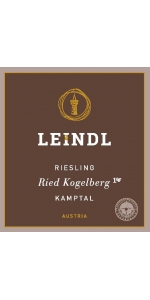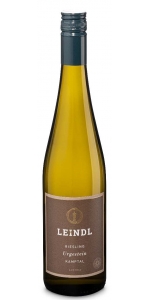Wine from Austria
Austrian wines are mostly made from the grape Gruner Veltliner, producing dry white wines. There is evidence of grape growing in Austria dating back nearly 4000 years.
Single vineyard Pinot Noir with a dark red brick color. Lots of ripe raspberries, wild strawberries, forest floor, cedar and a salty whiff of pine on the nose. The palate adds both herbal and peppery components as well as roasted coffee notes with a bit of caraway seed. Recommended to serve it slightly chilled in a round glass.
Braised beef with dumplings, lamb crown and brussels sprouts, roasted veal liver with pumpkin squash or tagliatelle with blue cheese.
Review:
"Deep crimson red with a purple hue, a subtle brightening on the rim. Candied violets, a hint of cassis, raspberries, black cherries, subtle notes of vanilla, a floral touch. Juicy, elegant, red cherries, a fresh acidity, a mineral-salty finish, red berry notes in the aftertaste, fresh and mineral, already drinking well, wonderful length, with ageing potential. - Peter MOSER"
- Falstaff (June 24th 2024), 95 pts
Pinot Noir is clearly the dedication of the Hartl Winery.
Strong garnet red, tending a little more towards brick-colored at the edge. On the nose, a complex abundance of herbs and dark berries, raspberry jam, thyme blossoms, dill, sage, violets and marzipan. Juicy on the palate, aromas of ripe raspberries, blueberries, rosehip tea and Mediterranean herbs, as well as hints of Assam tea. The elegant acidity gives a firm framework for the powerful body and highlights the fine-grained tannins. In addition to its classic ripe, typical Pinot fruit, the wine shows subtle notes of toast and smoked bacon in the long finish.
Pair with veal roast, leg of lamb with thyme and lemon, grilled Mediterranean vegetables, wild fowl like pheasant wrapped in bacon or duck with orange zest, prunes, roasted pumpkin and root vegetables.
Review:
"Deep crimson red with a purple hue, brightening on the rim. Ripe red fruit, floral nuances, a hint of cranberries, raspberry pulp and candied mandarin zest. Juicy, good complexity, red berry fruit, an attractive sweetness, well-integrated tannins, lingers, delicate notes of nougat in the aftertaste, full-bodied, versatile. - Peter MOSER"
- Falstaff (June 24th 2024), 93 pts
Hartl Rotgipfler Gumpoldskirchen Thermenregion DAC is made from 100% Rotgipfler.
The ancient Rotgipfler grape is packed with subtle fruit aromas of ripe peaches, juicy apricot and fresh pineapple. The inviting fruit aromas on the nose are complemented on the palate by orange zest, tangerine, vanilla and white pepper. Salty minerality supports a delicate structure with refined acidity.
The Rotgipfler grape has its name from the young shoots and veins of its leaves, which show a reddish (rot=red) color. It is indigenous to the Thermenregion and has become a rare variety, planted on about 120 ha only.
Acidity: 5.2 g/l
RS: 2.0 g/l
Excellent with intense spice (curry, chili, ginger, lemongrass) which can be found in Asian, Mexican and Italian cuisine.
Also counters its creamy texture with hollandaise and bechamel sauces, white meats, firm fish, poultry, Waldorff Salad or Eggs Benedict. A compliment also for mature cheeses, fig mustard and roasted nuts. Try Baked Camembert with honey, garlic and rosemary with a fresh baguette and salted butter.
Review:
"Pale golden yellow colour with silver reflections. Fresh yellow pears, delicate notes of meadow herbs and mango with fresh zest in the background. Medium body, fine nuances of white stone fruits, some melon, fine acidity, a lively food wine. - Peter MOSER"
- Falstaff (June 24th 2024), 92 pts
Hugl Gemischter Satz is made from 50% Grüner Veltliner, 40% Gelber Muskateller and 10% Riesling.
Gemischter Satz" has a long history in Austria. It is a field blend where different grape varieties are picked at the same time and vinified together:
In Vienna, the tradition of planting different and complementary grape varieties together in a vineyard – then harvesting and fermenting them together as well – has survived to the present day as Gemischter Satz. Thanks to the dynamic efforts of ambitious winegrowers, this traditional rarity has grown in stature and recognition to become the calling card of viticulture in Austria’s capital city.
Gemischter Satz is very popular in Vienna’s Heurigen (the Viennese term for wine taverns). Historically, Heurigen were simple places, where vineyard owners would open their doors during wine season to serve glasses of this years wine and juices to guests. At most, a plate of cold meats and cheese could be served along with the delicious wine.
For the traditional wines of Wiener Gemischter Satz - the planting of different grape varieties together in one vineyard - a unique style profile has been developed; a style that reflects the wine's origin-typical aromas and flavours. The regulation for the Wiener Gemischter Satz DAC requires that at least three white quality wine varieties must be planted together in one vineyard that is listed in the Viennese vineyard register as Wiener Gemischter Satz. The highest portion of one grape variety must be no more than 50%; the third highest portion must be at least 10%. Wines without vineyard indication must be dry and without any prominent wood flavour. The Wiener Gemischter Satz DAC can be marketed with an indication of vineyard site also. Single vineyard wines do not necessarily have to correspond with the “dry” taste indication, and they cannot be released for sale prior to March 1st of the year following the harvest. Minimum alcohol % of 12.5%.
Adds an enthusiastic Herbert Schilling, head of Vienna's Regional Wine Committee: “With the Wiener Gemischter Satz DAC, we've achieved a milestone in the consistent, years-long quality policy for wine growing in Vienna. The new regulations sharpen the origin profile of Wiener Gemischter Satz and, at the same time, reflect Vienna´s diversity in the glass.”
Hugl Gruner Veltliner (liter) is 100% Grüner Veltliner
This is an intense and concentrated wine offering pleasant citrus and grapefruit aromas, exotic tropical fruits with a hint of freshly ground white pepper. Full-bodied dry wine with a firm mineral backbone.
A firm mineral backbone, gives it the strength of character to work well with many cuisines.
Hugl Rosselberg Horse Hill Gruner Veltliner is made from 100% Grüner Veltliner
A powerful, very ripe Grüner Veltliner, intense and full-bodied with a long finish.
The ripe grapes are processed very gently with 12 hours on the skins and then vinified in Stainless Steel tanks. No Oak.
A firm mineral backbone, gives it the strength of character to work well with many cuisines.
SALE!
Hugl Sparkling Gruner Veltliner NV is made from 100% Grüner Veltliner.
Did you know that most of the base wines for Austrian sparkling wines come from our region? Poysdorf lies on the same line of latitude as Champagne and the climate is similar in both Champagne and the Weinviertel. This gives us enough reasons to expand our portfolio with a top-quality “sparkler”. Of course, it can only be a Veltliner-Sekt!
Pale golden color with a glint of green. Yellow fruit aromas, dry with a soft, juicy structure and a pleasing streak of minerality. Notes of crisp apple and pear.
The ripe grapes are gently pressed and fermented refrigerated.
Vinified in Stainless Steel tanks. No Oak.
A firm mineral backbone, gives it the strength of character to work well with many cuisines.
Hugl Zweigelt Classic is made from 100 percent Zweiglt.
Despite its relative youth, Zweigelt is actually an Austrian classic. This variety was created in 1922, when Dr. Fritz Zweigelt crossed two grapes - St Laurent and Blaufränkisch. Originally, it was intended for the new variety to be called Rotburger, referring to the place where it was born, Klosterneuburg. But this name never took hold, and instead, Zweigelt was named after the man who was the key in its development.
Today, Zweigelt is the most widely planted red variety in Austria, growing in nearly 9% of this country's vineyards. It is a robust grape, highly resistant to dryness, frost and various diseases.
The wine boasts a concentrated color, fruity and spicy aromas, cherry flavors. Full-bodied, smooth and round, the wine is an ideal food companion.
Despite its relative youth, Zweigelt is actually an Austrian classic. This variety was created in 1922, when Dr. Fritz Zweigelt crossed two grapes - St Laurent and Blaufränkisch. Originally, it was intended for the new variety to be called Rotburger, referring to the place where it was born, Klosterneuburg. But this name never took hold, and instead, Zweigelt was named after the man who was the key in its development.
Today, Zweigelt is the most widely planted red variety in Austria, growing in nearly 9% of this country's vineyards. It is a robust grape, highly resistant to dryness, frost and various diseases.
The wine boasts a pale rosé color, it has plenty of fruity aromas, with red cherry and wild strawberry flavors. It is medium-bodied, but it still have a nice long and pleasant finish with a light cinnamon type of spice to it.
Only the best grapes are harvested with a lot of experience and know-how and further processed. The grapes are fermented directly gently pressed and cooled. The fermentation takes place exclusively in stainless steel tanks.
Perfectly at home on any picnic, delicious with fried chicken, and tames the heat when paired with spicy dishes. There is also a slight watermelon note that makes it perfect for spring and summer. A great pairing with barbecued shrimp.
Despite its relative youth, Zweigelt is actually an Austrian classic. This variety was created in 1922, when Dr. Fritz Zweigelt crossed two grapes - St Laurent and Blaufränkisch. Originally, it was intended for the new variety to be called Rotburger, referring to the place where it was born, Klosterneuburg. But this name never took hold, and instead, Zweigelt was named after the man who was the key in its development.
Today, Zweigelt is the most widely planted red variety in Austria, growing in nearly 9% of this country's vineyards. It is a robust grape, highly resistant to dryness, frost and various diseases.
The wine boasts a pale rosé color, it has plenty of fruity aromas, with red cherry and wild strawberry flavors. It is medium-bodied, but it still have a nice long and pleasant finish with a light cinnamon type of spice to it.
Only the best grapes are harvested with a lot of experience and know-how and further processed. The grapes are fermented directly gently pressed and cooled. The fermentation takes place exclusively in stainless steel tanks.
Perfectly at home on any picnic, delicious with fried chicken, and tames the heat when paired with spicy dishes. There is also a slight watermelon note that makes it perfect for spring and summer. A great pairing with barbecued shrimp.
SALE!
Hugl Zweigelt Secco Rose is made from 100% Zweigelt
Despite its relative youth, Zweigelt is actually an Austrian classic. This variety was created in 1922, when Dr. Fritz Zweigelt crossed two grapes - St Laurent and Blaufränkisch. Originally, it was intended for the new variety to be called Rotburger, referring to the place where it was born, Klosterneuburg. But this name never took hold, and instead, Zweigelt was named after the man who was the key in its development.
Today, Zweigelt is the most widely planted red variety in Austria, growing in nearly 9% of this country's vineyards. It is a robust grape, highly resistant to dryness, frost and various diseases.
Lively, fruity bouquet of strawberry, cherry and floral aromas. Refreshing and beautifully balanced, this is a great wine to enjoy as an aperitif. This is a Secco for the whole day and the whole night
The wine is made of 100% Zweigelt grapes of 15-35 years old (25 years old in avarage).
The soil is mainly loam and loess.
It is made using the Charmat method and the wine is aged for 3 months on the lees in stainless steel tanks.
The wine is slightly filtered before bottling.
Drink by itself as an aperitif, it is also a great picnic or brunch wine and will be a good pick to celebrate any occasion.
Leindl Gruner Veltliner Eichelberg is made from 100% Gruner Veltliner.
Medium yellow green. Fine yellow apple fruit, delicate hint of quince and honey, candied orange zest, highly attractive bouquet. Juicy, good complexity, extract core sweet, silky texture, fine acidity bow, fine and salty minerality, great length, secure aging potential, a very finesse Veltliner-style.
Cold Fermentation.
Aged on the lees for 12 months in Stainless Steel tank. No Oak.
Leindl Gruner Veltliner Langenlois is made from 100 percent Gruner Veltliner.
This classic Gruner Veltliner comes from the famous wine-growing region of Langenlois. A very typical fruity and fresh Gruner Veltliner offering green apples, juicy, minerality, a pleasant body and a good length. It is ideal with a wide range of dishes.
Cold Fermentation.
Aged on the lees for 6 months in Stainless Steel tank. No Oak. No ML.
Produced from vines of 5-20 years old on slate soils.
Leindl Gruner Veltliner Seeberg Kamptal is made form 100 percent Gruner Veltiner. Medium yellow green. Fine yellow apple fruit, delicate hint of quince and honey, candied orange zest, highly attractive bouquet. Juicy, good complexity, extract core sweet, silky texture, fine acidity bow, fine and salty minerality, great length, secure aging potential, a very finesse Veltliner-style.
Review:
“Inviting nose, with layers of quince and elegant, aromatic herb leading through to a richly textured palate of opulent fruit and a fine acidity.”
- Decanter World Wine Awards 2023, 96 pts
Leindl Gruner Veltliner Seeberg Kamptal is made form 100 percent Gruner Veltiner. Medium yellow green. Fine yellow apple fruit, delicate hint of quince and honey, candied orange zest, highly attractive bouquet. Juicy, good complexity, extract core sweet, silky texture, fine acidity bow, fine and salty minerality, great length, secure aging potential, a very finesse Veltliner-style.
Review:
"Here’s a wonderfully cool and elegant Gruner Veltliner with mountain freshness that makes it very enticing. Medium-bodied and quite sleek, but with a touch of marzipan richness on the mid-palate, then a stunning wet-stone freshness in the long and polished finish. Drink or hold. - Stuart PIGOTT"
- James Suckling (October 10th 2024), 95 pts
Leindl Riesling Zobinger Heiligenstein Kamptal is made from 100 percent Riesling.
Medium yellow green. Fine nuances of ripe apricot, a hint of yellow apple, delicate herbs and spices, mineral Touch, hints of candied orange zest. Juicy, elegant, fine stone fruit, touch of finesse acidity, salty minerality in the finish, remains long, already well to drink.
Cold Fermentation.
Aged on the lees for 12 months in Stainless Steel tank. No Oak.
No ML
Review:
"Aged on the lees for 12 months in stainless steel, this wine saw no oak. Its original name – Hellenstein -- referred to hell stone, as the vineyards are on a mountain where the “sun burns like hell.” It was later renamed Heiligenstein, which translates as holy rock, and is a geological island of desert sandstone, with volcanic matter. Its earthy slate character lends out scents and flavors of honeyed apricot, salty pears, and stone fruit pith."
-The Tasting Panel (May/June 2022), 94 pts
Leindl Riesling Zobinger Heiligenstein Kamptal is made from 100 percent Riesling.
Medium yellow green. Fine nuances of ripe apricot, a hint of yellow apple, delicate herbs and spices, mineral Touch, hints of candied orange zest. Juicy, elegant, fine stone fruit, touch of finesse acidity, salty minerality in the finish, remains long, already well to drink.
Cold Fermentation.
Aged on the lees for 12 months in Stainless Steel tank. No Oak.
No ML
Review:
"Anything but dramatic, this is a concentrated and beautifully crafted Heiligenstein dry riesling with the racy acidity and stony minerality we expect from this site. Very sleek and straight finish that some may find a bit tart, but we find very exciting. Sustainable. Drink or hold. - Stuart PIGOTT"
- James Suckling (Top 100 wines of Austria 2023, December 5th 2023), 94 pts
Leindl Riesling Zobinger Heiligenstein Kamptal is made from 100 percent Riesling.
Medium yellow green. Fine nuances of ripe apricot, a hint of yellow apple, delicate herbs and spices, mineral Touch, hints of candied orange zest. Juicy, elegant, fine stone fruit, touch of finesse acidity, salty minerality in the finish, remains long, already well to drink.
Cold Fermentation.
Aged on the lees for 12 months in Stainless Steel tank. No Oak.
No ML
Review:
"This excellent expression of the Heiligenstein site has a wonderful youthful tension. The sleek, medium-bodied palate features understated power, great precision and Amalfi lemon freshness. Very long, focused finish with a cascade of dry flowers. Sustainable. Drink or hold. - Stuart PIGOTT"
- James Suckling (September 12th 2024), 95 pts
Leindl Riesling Ried Kogelberg is made from 100 percent Riesling.
Kogelberg is known as a Grand Cru vineyard.
Delicate yellow tropical fruit paired with overripe apricots. Juicy, good complexity, fruity sweetness of ripe peaches, pleasant acidity, citrus touch in the aftertaste, good aging potential.
Review:
"Striking aromas of wild thyme and rosemary. Juicier than the nose suggests, this is a vibrant and complex dry riesling. I love the stoniness in the long, polished finish. Sustainable. Drink or hold.- Stuart PIGOTT"
- James Suckling (September 12th 2024), 94 pts
Leindl Riesling Urgestein is made from 100 percent Riesling.
Leindl Riesling Zobinger Heiligenstein Kamptal is made from 100 percent Riesling.
Medium yellow green. Fine nuances of ripe apricot, a hint of yellow apple, delicate herbs and spices, mineral Touch, hints of candied orange zest. Juicy, elegant, fine stone fruit, touch of finesse acidity, salty minerality in the finish, remains long, already well to drink.
Cold Fermentation.
Aged on the lees for 12 months in Stainless Steel tank. No Oak.
No ML
Review:
"Aged on the lees for 12 months in stainless steel, this wine saw no oak. Its original name – Hellenstein -- referred to hell stone, as the vineyards are on a mountain where the “sun burns like hell.” It was later renamed Heiligenstein, which translates as holy rock, and is a geological island of desert sandstone, with volcanic matter. Its earthy slate character lends out scents and flavors of honeyed apricot, salty pears, and stone fruit pith."
-The Tasting Panel (May/June 2022), 94 pts
- back
Selected Options
Countries
Categories
Pricing
Countries
Regions
Grape Types
Wineries
Organic/Free Shipping
Clos du Val Estate Cabernet Sauvignon is made from 6% Cabernet Sauvignon, 7% Merlot, 5% Malbec and 1% each Cabernet Franc and Petit Verdot.
This fresh and vibrant Napa Valley Cabernet Sauvignon is brimming with aromas of blackberry, mulberry, cassis, and violet. On the palate, bright flavors of cranberry, red plum, cherry, and lavender are intertwined with supple tannins, balanced acidity, and a long, smooth finish.
Review:
"Sleek tannins, guided by sweet earth, slate, purple plum and black olive. Savory notes of fig, toasted cedar, and black tea meld with blackberries. Well structured and impeccably balanced."
-Tasting Panel 96 Points
Long Shadows Poets Leap Riesling is made from 100 percent Riesling.
Tasting Notes: The Poet's Leap Riesling offers aromas of white peach, jasmine, Thai basil and nutmeg. Flavors of ripe melon, apricot and an appealing minerality continue across the palate. An underlying hint of honey sweetness is balanced by a streak of bright acidity that provides a long, clean finish.

